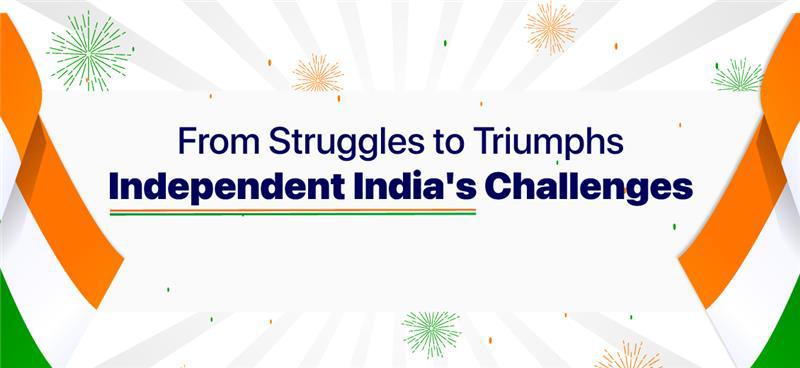From Struggles to Triumphs: Independent India's Challenges
Blogs Home
- 14 Aug 2023

With the resounding cries of "Swaraj" echoing through the streets and the passionate pursuit of freedom fueling the hearts of millions, India emerged from the shadows of British colonial rule on that historic day, August 15, 1947. The tireless efforts of leaders like Mahatma Gandhi, Jawaharlal Nehru, and countless others eventually led to India's independence. And then, the country embarked on a nation-building journey, faced with multifaceted challenges that required resilience, determination, and ingenuity to overcome. On this occasion of Independence Day, let's focus on some major challenges that India had to face in being independent.
Complex Constitutional Framework
One of the most significant achievements of Independent India was framing the Indian Constitution. Dr B.R. Ambedkar led the drafting committee, and on January 26, 1950, India adopted its new Constitution, establishing a democratic and federal structure. However, building a robust democracy came with its own set of challenges, including the need to accommodate diverse linguistic, cultural, and religious groups within a single nation. The concept of federalism had to be balanced with the central government's authority, ensuring equitable representation and power-sharing.
The Constitution of India, inspired by democratic principles and values, laid the foundation for a country that would be governed by the Rule of Law. It provided some fundamental rights to its citizens, aiming to promote social justice and equality. However, implementing these ideals on such a vast and diverse population proved to be a challenge. Caste-based discrimination, social inequalities, and gender disparities persisted and required continuous efforts to address.
Integration of Princely States
At the time of independence, India faced the challenge of integrating over 500 princely states into the newly independent nation. The states had the option to join India or Pakistan or stay independent. Sardar Vallabhbhai Patel, the first Deputy Prime Minister and Home Minister of India, played a crucial role in persuading most princely states to accede to India. This process was marked by complex negotiations, diplomacy, and, in some cases, military action. By 1949, India managed to integrate most of these states into its territory.
The integration of princely states was critical to maintaining the territorial integrity of India. It required careful negotiation and respect for the diverse identities and aspirations of these states' rulers and populations. The success of this integration was a testament to India's ability to forge a united and diverse nation despite the challenges it faced in the aftermath of partition.
Nation-Building and Social Issues
Nation-building after independence required addressing various social issues that had plagued India for centuries. The government launched initiatives to combat poverty, illiteracy, and social inequality. Land reforms were undertaken to distribute land more equitably among farmers. The Green Revolution in the 1960s transformed India from a food-deficit nation to a self-sufficient one, improving agricultural productivity. Reservation policies and affirmative action were taken to uplift marginalized communities.
India's journey towards social progress and equality has been ongoing. Poverty, though reduced significantly over the years, continues to be a pressing issue. Access to education and healthcare remains uneven, particularly in rural areas. Gender disparities and discrimination persist in many aspects of society, challenging India's path to true inclusivity and social justice.
Economic Challenges
Independent India faced daunting economic challenges. The country adopted a planned economic model with five-year plans to promote industrialization and economic development. The government emphasized self-reliance and import substitution to reduce dependency on foreign goods. However, in the 1990s, India faced a severe economic crisis, prompting the shift to liberalization and globalization policies.
Economic reforms 1991, popularly known as "liberalization, privatization, and globalization" (LPG), were initiated with an aim to liberalize the Indian economy, attract foreign investments, and foster private sector growth. These reforms were initiated to open up the Indian market to foreign investments and promote a more market-oriented economy and led to increased growth and global integration.
Although instrumental in laying the groundwork for industrialization and infrastructure development, the planned economic model had its limitations. It led to inefficiencies, bureaucratic red tape, and a lack of competitiveness in certain sectors. The economic reforms of the 1990s sought to address these challenges, leading to increased foreign investment, technological advancements, and economic growth. However, they also brought forth the issues like income inequality and the need to strike a balance between economic liberalization and social welfare.
Foreign Policy- The Ultimate Challenge
India's foreign policy aims to maintain strategic autonomy and peaceful coexistence with other nations. The country advocated non-alignment during the Cold War, choosing not to align with any major power blocs. India sought to foster strong diplomatic ties with various countries and played a crucial role in peacekeeping efforts under the United Nations.
The policy has also been characterized by pragmatism and the pursuit of its national interests while upholding its commitment to international peace and cooperation. Balancing its relationships with major powers and neighbouring countries has been delicate, especially in regional dynamics and geopolitical tensions. India's foreign policy, characterized by its pursuit of strategic autonomy and peaceful coexistence, presents a dynamic challenge. In an era dominated by Cold War divisions, India's steadfast commitment to non-alignment, a neutral stance, drew both admiration and criticism. The West, at times, labeled India's foreign policy as 'confused' due to its refusal to align with major power blocs. India's position as a rising global power brings both opportunities and challenges, necessitating a careful and nuanced foreign policy approach.
Indo-Pak Relations
The partition of India led to violence and mass migrations, leaving deep scars. The two countries have fought multiple wars and faced ongoing issues over the disputed region of Kashmir. Despite numerous peace talks and efforts, finding a lasting resolution to their differences has remained elusive.
The historical and territorial complexities between India and Pakistan have posed enduring challenges to peace and stability in the region. The issue of Kashmir, a long-standing point of contention, has significantly hindered building trust and fostering sustainable peace between the two nations. Terrorist incidents and cross-border infiltrations have added to the tensions, necessitating constant efforts to defuse crises and initiate dialogue.
Indo-China Relations
India's relationship with China has been complex, marked by both cooperation and tension. The border dispute led to a brief war in 1962, and the issue remains unresolved. India strives to maintain diplomatic ties with China while safeguarding its territorial integrity.
China's assertive stance on territorial claims in border regions has remained a matter of concern for India. The 2020 border standoff in the Himalayan region further escalated tensions between the two countries. Managing this delicate relationship demands diplomatic acumen and a commitment to the peaceful resolution of disputes.
Security Concerns
India has faced various security challenges, including internal conflicts, insurgency in certain regions, and the threat of terrorism. The country's security forces have been engaged in counterterrorism efforts and maintaining law and order.
Internal security challenges, such as the Naxalite-Maoist insurgency and the Kashmir conflict, have been significant hurdles in India's pursuit of peace and stability. The government's efforts to address the root causes of these conflicts while ensuring national security have been ongoing.
Driving Positive Transformation with Social Movements and Reforms
The country has witnessed significant social movements and reforms that have shaped its social fabric. The women's empowerment movement and reservation policies for marginalized communities have aimed to create a more inclusive society. The push for gender equality and social justice continues.
The impact of social movements and reforms has been transformative in certain aspects, promoting inclusivity and empowering marginalized communities. However, deep-rooted societal norms and cultural attitudes have presented obstacles to achieving full equality and justice for all. Sustained efforts and continued advocacy remain essential in the quest for a more equitable society.
Forces for Good - Political Developments
India's political landscape has evolved over the years. The country has a multi-party system, and maintaining a vibrant democracy with diverse political ideologies has been a constant challenge.
India's democracy, with its regular elections and peaceful transitions of power, has been a remarkable achievement. However, the democratic system has also faced challenges such as corruption, caste-based politics, and money's influence in elections. Strengthening democratic institutions and promoting transparency and accountability are vital for India's political progress.
Shaping a Brighter Tomorrow with Technological Advancements
The country has achieved significant space exploration milestones and emerged as a global IT and software services hub. However, bridging the digital divide and ensuring access to technology for all remains a challenge.
India's strides in space research, information technology, and communication have earned recognition on the global stage. However, the digital divide, characterized by unequal access to technology and internet connectivity, persists, hindering the goal of creating a digitally inclusive society. Bringing technology to remote and underserved areas remains a priority for the government.
Environmental Issues
India has taken steps to promote sustainability and conservation efforts. The country's rapid economic growth has often come at the cost of environmental degradation. Air pollution, especially in major cities, poses severe health risks to citizens. Water scarcity and contamination continue to raise significant concerns in certain regions. Climate change and its impact on agriculture and natural resources necessitate a greater focus on sustainable development and green initiatives.
Health and Education
Progress has been made in the healthcare and education sectors, but challenges persist, such as ensuring access to quality healthcare and education for all citizens.
India has significantly improved healthcare services and outcomes, particularly in areas like vaccination, maternal and child health, and communicable disease control. However, disparities in access to healthcare remain between urban and rural areas. In the education sector, while efforts have been made to expand access and improve the quality of education, issues like dropouts, teacher shortages, and outdated curricula persist.
Disaster Management
India has been vulnerable to natural disasters and has been continuously working on disaster preparedness and response mechanisms.
With its diverse geographical and climatic conditions, India is susceptible to various natural disasters, including cyclones, earthquakes, floods, and droughts. The government's focus on disaster management, early warning systems, and relief efforts has been crucial in mitigating the impact of these disasters and assisting affected communities.
International Collaborations for Inclusive Development
India actively engages with international organizations and forums, contributing to global issues like climate change and sustainable development. Active participation of the country in international collaborations is motivated by its commitment to global causes and the understanding that addressing global challenges requires collective action. The country's active role in forums like the United Nations and its engagements in initiatives related to climate change, sustainable development, and humanitarian aid reflect its position as a responsible global citizen.
Recent Developments
In recent times, India has faced various challenges related to governance, social justice, economic growth, and positioning itself as a global player. The country continues to tackle these issues with determination and a vision for a brighter future.
India has witnessed rapid economic growth and development in recent years, lifting millions out of poverty. Though challenges like rising income inequality, unemployment, and agrarian distress remain, the government's initiatives in areas such as Make in India, Digital India, and Skill India reflect the efforts to address these challenges and foster inclusive growth.
India's global positioning has evolved, and it has become a significant player in international affairs. It has deepened its partnerships with various countries, including those in Southeast Asia, Africa, and the Middle East, to promote economic and strategic interests. Challenges in maintaining cordial relationships with certain countries and managing regional conflicts continue to be areas of focus for India's foreign policy.
References -
- https://www.cfr.org/global-conflict-tracker/conflict/conflict-between-india-and-pakistan
- https://www.cfr.org/in-brief/china-india-border-dispute-what-know
- https://www.google.com/amp/s/www.thehindu.com/opinion/op-ed/the-story-of-indias-integration/article29094867.ece/amp/
- https://www.idsa.in/strategicanalysis/36_2/PoliticalIntegrationofNortheastIndia_ThongkholalHaokip
- https://www.indiascience.in/videos/the-green-revolution-indias-independence-and-scientific-community-e
Poonam Sharma

Poonam Sharma is a graduate in civil engineering. She is an old soul who loves music, dance, art! Apart from these, she likes to immerse herself in writing, singing and sketching; this is how she expresses art.
Blogs Home



